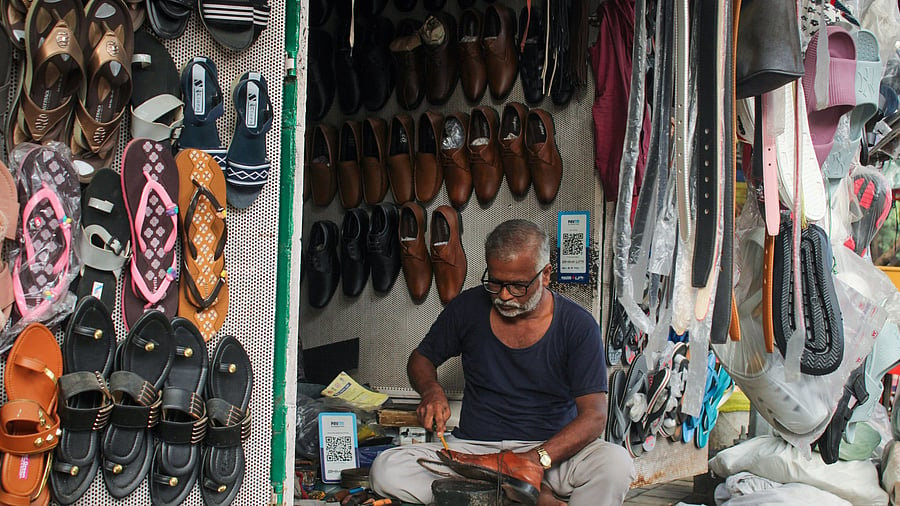
A cobbler at work in Bengaluru.
Credit: Special arrangement.
Leo Tolstoy begins his short story ‘Where love is, God is’ with the observation: “There was hardly a pair of boots in the neighbourhood that had not passed through his hands at least once or twice, so he often saw his own handiwork through the window.” The short story revolves around the life of a skilled cobbler named Martin, who lives in a Russian neighbourhood.
The life of Mariswamy, a 52-year-old cobbler from Hassan’s Channarayapatna, seems to mirror that of Tolstoy’s protagonist. He packs all his cobbling tools into a once-white, now-grey side bag and roams the streets of Channarayapatna.
“I have regular customers who chance upon me when they visit pete (the city) and get their slippers repaired,” Mariswamy explains. “I see some of them every day, glance at their slippers and estimate when they might break again,” he adds.
However, Mariswamy faces a unique problem. His regular customers often leave without paying a single rupee. They scold him for what they perceive as flawed work, as their slippers tend to break again in just 10 days.
“What can I do? I have repaired the same slipper four or five times. They work in the fields every day, so it is prone to wear and tear,” Mariswamy says with a hint of frustration. “I smile and repair them again because I enjoy fixing slippers. Sometimes, I argue with them because I need to feed my family,” he adds.
Like Mariswamy are many other cobblers in Channarayapatna, Chikkamagaluru and Mysuru. But they work in small kiosks. Their monthly income ranges from Rs 5,000 to 7,000. In Channarayapatna, cobblers travel to Hassan city twice or thrice a month, 40 kilometres from their homes, to bring supplies for their work.
Saturdays are particularly profitable for them, as they visit the traditional ‘shanivarada raithara santhe’ (the Saturday farmers’ market), held across various Gram Panchayats. Villagers who come to the santhe for vegetables and other produce also get their footwear fixed here.
Cobblers in metropolitan Bengaluru face a different set of challenges. They not only compete with other cobblers for business but also with large companies enterprises.
Murugan, who repairs slippers in his small kiosk on Koramangala Main Road, notes a steady decline in customers over the last 15 years.
“When the market is filled with disposable slippers that cost around Rs 150-200, why would customers bother getting their footwear repaired?” asks the 62-year-old, who has been cobbling for 42 years.
He explains that household expenses of a family could be met by income derived from cobbling 15 years ago. However, a drastic change in the footwear market has altered that dynamic. However, he remains undiscouraged.
Murugan credits LIDKAR (a wing under the Social Welfare Department) as a game-changer for cobblers. LIDKAR provides short-term and long-term loans to help cobblers set up kiosks for their businesses.
Cobblers adapt
Bengaluru cobblers did not stop there. “As the market was flooded with low-cost footwear, we started selling shoes too. With LIDKAR’s loan, we purchased inexpensive footwear at lower prices and began to sell them for a nominal profit,” says a cobbler in Suddaguntepalya.
The addition of footwear sales has proven to be very profitable. Cobblers have gradually adapted to changes in the market. In their kiosks across the city, one can also find belts, bags, socks, umbrellas and even helmets.
However, securing loans is not easy for every cobbler. They often have to pay middlemen to get the necessary paperwork.
Despite these hurdles, cobblers continue to adapt and move forward.
Murugan enthusiastically mentions that he now makes Rs 20,000–25,000 every month, an increase from the Rs 10,000–15,000 he earned a few years ago. He charges Rs 20-40 for patchwork and Rs 120-150 for full repair work.
While he acknowledges a decline in the number of people seeking repairs, he expresses no fear of facing days with zero customers. Amid global discussions about AI threatening various jobs, the cobblers’ ability to adapt offers a fresh perspective.
The primary reason cobbling has endured, even as footwear design and aesthetics take precedence, is that cobblers have developed skills to repair footwear without compromising its appearance, while ensuring comfort.
“We have survived big machinery and market changes. If those have not led to ‘no customer days’ for us, then there is nothing that can wipe out our cobbling businesses,” Murugan asserts, a sentiment echoed by several others in the profession.
A cobbler at work in Bengaluru.